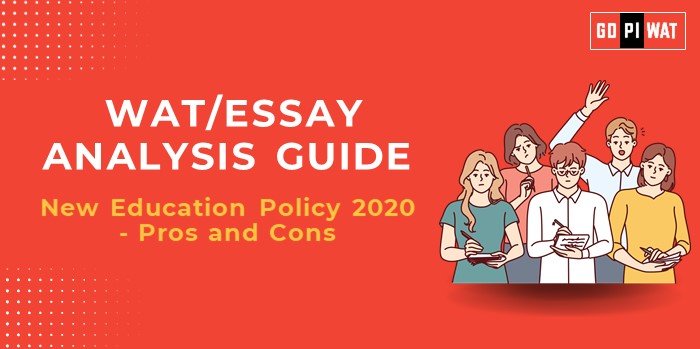📜 Understanding NEP 2020’s Importance
The National Education Policy (NEP) 2020 aims to align India’s education system with global standards while fostering a knowledge-driven economy. For B-school applicants, understanding its implications on digital learning, equity, and multidisciplinary approaches provides a critical perspective on India’s socio-economic priorities.
📋 Effective Planning and Writing
- ⏱️ Time Allocation: Plan (5 mins), Write (20 mins), Review (5 mins).
- 🔍 Preparation Tips: Research verified data, key policy changes, and impacts on stakeholders.
💡 Introduction Techniques for Essays
- ⚖️ Contrast-Based Introduction: “NEP 2020 sets ambitious goals for an inclusive education system, yet the rural-urban digital divide remains a challenge.”
- 🔧 Solution-Oriented Approach: “Integrating vocational training and flexible learning, NEP 2020 bridges the gap between academia and the job market, though implementation challenges persist.”
- 📅 Timeline Approach: “From rote-based education to skill-oriented learning, NEP 2020 represents India’s pivot toward global educational standards.”
🔍 Structuring the Essay Body
🏆 Achievements
- 🎓 Multidisciplinary approach with the 5+3+3+4 system.
- ⚙️ Vocational education from Grade 6 and technology integration.
- 📈 Improved GER and inclusivity goals.
⚠️ Challenges
- 🌐 Digital and funding gaps.
- 📊 Variability in state-level implementation.
- 🌍 Addressing regional disparities.
🚀 Future Outlook
- 📡 Recommendations on improving digital infrastructure in rural regions.
- 🤝 Focus on sustainable public-private partnerships to close funding gaps.
📝 Concluding Effectively
- ⚖️ Balanced Conclusion: “NEP 2020’s success hinges on inclusive implementation, requiring robust digital infrastructure and targeted funding.”
- 🌎 Global Comparison Conclusion: “NEP’s vision aligns with global standards like Singapore’s and Finland’s models, positioning India for potential educational leadership, provided challenges are met.”
🔎 Analysing Successes and Shortcomings
- 🏆 Key Achievements: Flexibility, digital readiness, foundational literacy, and vocational inclusion.
- ⚠️ Ongoing Challenges: Digital access disparities, funding shortages, regional implementation variability.
- 🌍 Global Context: Finland’s student-focused curriculum and Singapore’s digital integration highlight effective paths for NEP.
🌟 Recommendations for Sustainable Progress
- 📡 Digital Infrastructure: Prioritize rural connectivity to bridge digital divides.
- 🤝 Private Partnerships: Engage private sector for vocational training support and infrastructure.
- 🌍 Localized Policy Implementation: Tailor strategies for states with limited resources to improve adoption and impact.
📝 Sample Short Essays on NEP 2020
- ⚖️ Balanced Perspective: “NEP 2020 seeks to modernize India’s education with flexibility and inclusivity, though rural access remains a concern.”
- 🔧 Solution-Oriented: “By integrating vocational skills early, NEP 2020 positions students for diverse career paths, yet faces challenges in equitable implementation.”
- 🌍 Global Comparison: “NEP’s model resonates with Finland’s holistic approach, yet India’s digital infrastructure must improve to achieve comparable success.”


